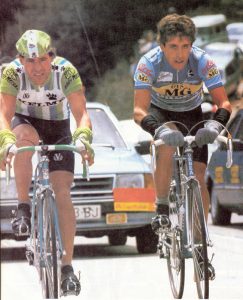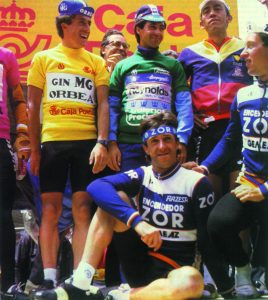1985. Orbea. Win La Vuelta.
Pedro Delgado changed teams. The Reynolds team had too many leaders (Arroyo, Gorospe and him) and his directeur sportif, José Miguel Echavarri, let him leave. He ended up in Orbea, a new professional team, which was betting on Pedro because of his special qualities for the big tours. In the Tour of Spain he got his revenge on the previous year’s stage of the Lagos de Enol , where he lost the yellow jersey. This time he won the stage and was awarded the coveted jersey again, robbing it from the very young Miguel Induráin, who at the age of 20 had been, up till then, the youngest leader of the Tour of Spain.
The next day he didn’t feel very well and so lost the leadership of the race, which passed, fortunately, into the hands of his team-mate, Peio Ruiz Cabestany. From that stage onwards, the 7th, Pedro just couldn’t find his place in the race, he was not feeling 100 per cent and even though his directeur told him he had to keep on fighting, that he was the leader of the team, there was nothing he could do to keep in the fight.
Then came the last stage but one, from Alcalá de Henares to Segovia, which was also the last mountain stage. In the overall classification, Delgado was over six minutes behind Millar, the leader. So his wheel was not the wheel to watch, the dangerous ones being those of Pacho Rodríguez and Cabestany. He attacked on numerous occasions on the Cotos mountain pass so as to weaken the leader’s team, but they wouldn’t let him go. He had to take advantage of the bad weather (rain, hail, fog,) and tried once more at the beginning of the descent from the Navacerrada mountain pass. With visibility at nearly nil, he took a risk on the first few bends and managed to get away from his opponents. He dreamed of winning the stage for his fellow countrymen. Ahead of him was Recio who had escaped earlier and when Pedro finally caught up with him, the latter got on his wheel. Delgado, knowing that on his own he would get nowhere, tried to come to an agreement with his break companion to increase the gap which would make Millar work harder (with no team mates to help him) and thus favour his own team-mate, Cabestany.
The difference between the two breakaways and the leader increased. The gap was important, with 40nkms to go they were already 2 minutes up. So Pedro pedalled on like mad along the familiar roads where he had shed many drops of sweat, knowing that he was aspiring to the most important victory of his sports career. On the finish line in Segovia, Recio came first; followed by Delgado who now led Millar by 6’46». He became the new leader, to the delight of his incredulous fellow countrymen. This time the goddess of fortune had been on his side.
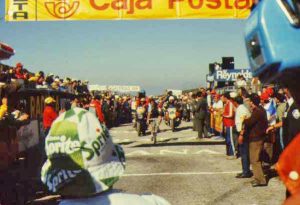 |
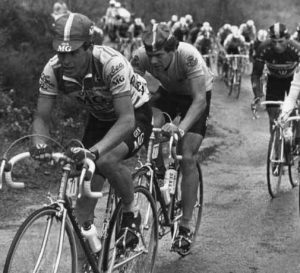 |
| La Vuelta 1985. Victory in the Covadonga Lakes and Pedro moves into yellow. | On the road to Tremp in 1985, helping his team-mate, Peio Ruiz Cabestany. |
«I knew I had to attack and if I couldn’t do it uphill, I would try it on the descent. In spite of the cold and the rain, the weather was an advantage as the roads were very slippery. Millar’s directeur sportif didn’t bother to inform him of our escape because we were so far behind in the overall. Besides, the 10″ that separated Millar from Pacho (2nd in the general classification), also helped me; the Scot didn’t want to risk it and make too much of an effort early on in the stage, as he didn’t want to suffer the consequences later. So he stopped and started the whole time, for fear of the Colombian. Each one played his cards and we were the lucky winners».
After having won the 1985 Tour of Spain, Pedro started off the Tour of France with great moral strength. However, at the first opportunity, in the team time trial on the 4th stage, his team, the Seat-Orbea, came last, 7 minutes behind the winners. It was a bitter cup for someone who aspired to the podium of the Tour. Things got even more complicated in the first individual time trial at Strasburg of 75kms. He lost 5’38» to Hinault and ended up 44th in the General Classification. Up till then he had never lost so much time in the first time trial, but this year he wasn’t doing well.
Then the mountains came and he began to improve but somehow he just couldn’t find his feet, he was not concentrating and couldn’t keep the wheel of the best. He had to make enormous effort to overcome this and keep in with the leaders. He managed to make up some of the time lost but then at the Villard de Lans time trial of 32-kms, a bout of flu that had plagued him for 2 days previously, made him lose nearly a further four minutes to Hinault.
Emerging from the fog at Luz Ardiden, he achieved what had so far been denied to him in his previous participation in the Tour de France; a stage victory. He also got 4 minutes closer to Hinault. The brilliant stage victory was a clear result of perfect strategy, put into action first by his team-mate, José del Ramo and finished off by Cabestany . The following day, he was 6th on the stage finishing on the Aubisque and went up to 6th place in the overall where he remained till the finish.
«It was a good season as far as results go, but I was in better form in 1984. It’s been a year of contradictory feelings; on the one hand I’m very happy about the successes but not so happy with my time trial performance. Maybe I raced a bit too much; after the Tour of Spain, I competed in the Tour of Colombia and immediately afterwards, in the Tour of France. The thing is I was never at ease at any moment while I was competing as I was mentally tired».
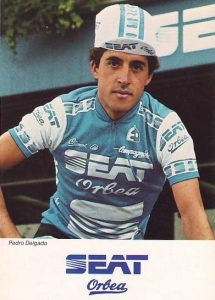 |
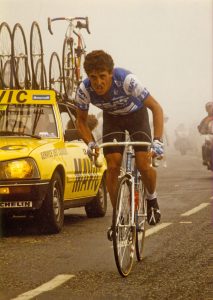 |
| After the victory in La Vuelta, the team was renamed Seat-Orbea. | Luz Ardiden. Pedro take his first Tour de France stage win, on a foggy day in 1985. |
